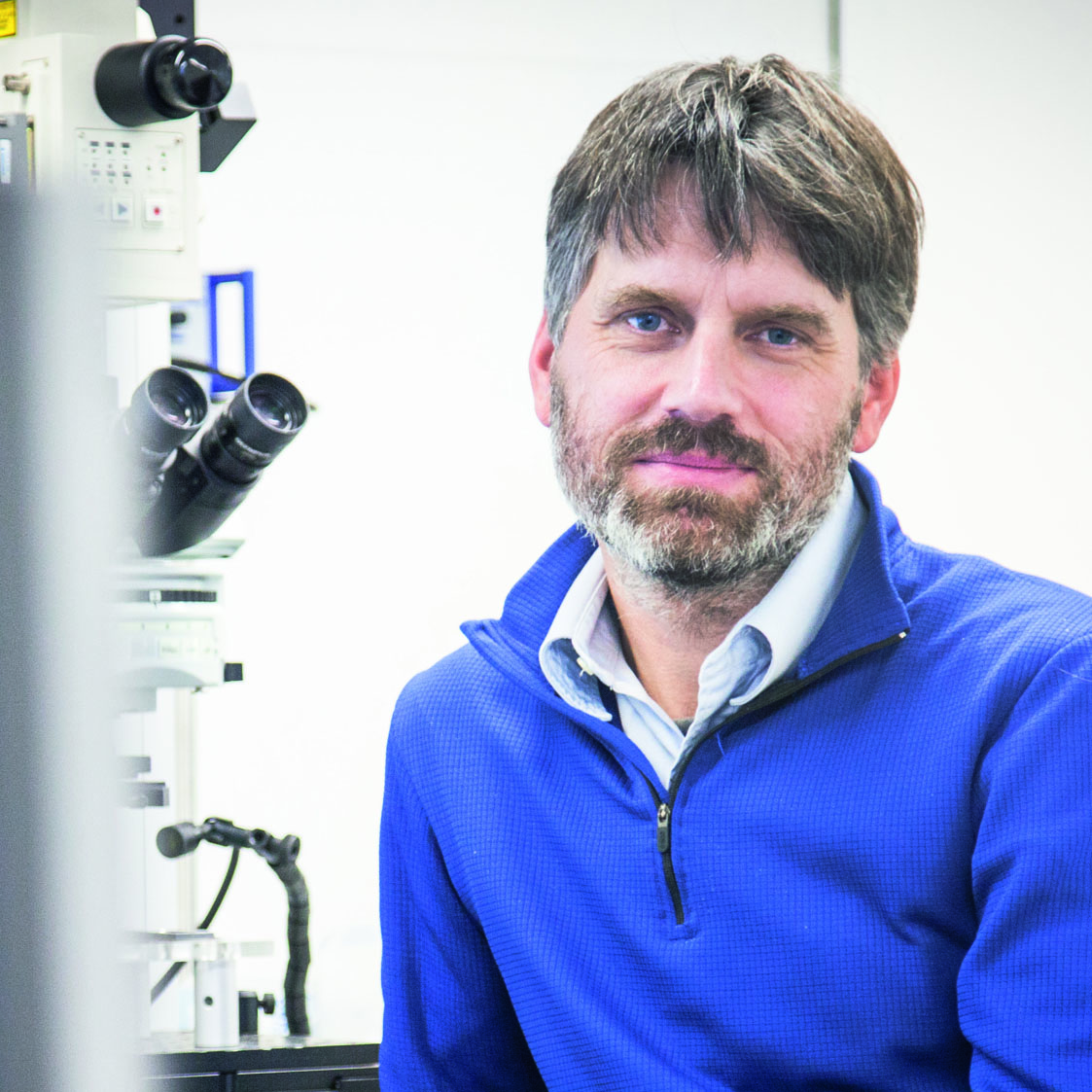Team
Neuroscience

We study how Alzheimer’s disease develops in the brain on the molecular and cellular level and develop new diagnostic, therapeutic and preventive approaches. Additionally, using proteomics we try to predict possible side effects of Alzheimer-targeted drugs, thus making drug development safer. For our interdisciplinary research we use a variety of modern methods from biochemistry, proteomics, molecular, cellular, neurobiology, in vitro and in vivo models of Alzheimer’s disease. The focus of our research is on proteases of the ADAM (alpha-secretase) and BACE (beta-secretase) families as well as on microglia-dependent inflammatory processes, which have a central role in Alzheimer’s pathogenesis.
Selected examples of our recent research:
ADAM10: We identified this metalloprotease as the Alzheimer’s alpha-secretase, which is able to prevent the molecular pathogenesis leading to Alzheimer’s disease. We found that ADAM10 cleaves numerous additional proteins in neurons. An example is the cell adhesion protein NrCAM, for which we established that cleavage is necessary for the correct outgrowth of axons.
BACE1: We discovered that this major Alzheimer’s drug target cleaves numerous proteins in the nervous system, and has a key role in the function of the brain. An example is seizure protein 6 (SEZ6), where the proteolytic cleavage is required for synapse formation/maintenance.
Neuroproteomics: We have two Orbitrap mass spectrometers. One example of our work is the development of the proteomic hiSPECS method for secretome analyses. Another example is the proteomic analysis of cerebrospinal fluid (CSF), which is now possible with only few microliters of CSF from different organisms.
Selected publications:
Pigoni, M., et al. (2020). Seizure protein 6 controls glycosylation and trafficking of kainate receptor subunits GluK2 and GluK3.
EMBO J, in press.
Rudan Njavro, J., et al. (2020). Mouse brain proteomics establishes MDGA1 and CACHD1 as in vivo substrates of the Alzheimer protease BACE1.
FASEB J, in press.
Fecher, C., et al. (2019). Cell-type-specific profiling of brain mitochondria reveals functional and molecular diversity.
Nat Neurosci 22, 1731-1742.
Lichtenthaler, S.F., and Guner, G. (2019). Pathology-linked protease caught in action.
Science 363, 690-691.
Brummer, T., et al. (2019). NrCAM is a marker for substrate-selective activation of ADAM10 in Alzheimer's disease.
EMBO Mol Med 11.
Parhizkar, S., et al. (2019). Loss of TREM2 function increases amyloid seeding but reduces plaque-associated ApoE.
Nat Neurosci 22, 191-204.
Lichtenthaler, S.F., et al. (2018). Proteolytic ectodomain shedding of membrane proteins in mammals - hardware, concepts, and recent developments.
EMBO J 37.
Colombo, A., et al (2018). Non-cell-autonomous function of DR6 in Schwann cell proliferation.
EMBO J 37.
Kuhn, P.H., et al. (2012). Secretome protein enrichment identifies physiological BACE1 protease substrates in neurons.
EMBO J 31, 3157-3168.
https://www.dzne.de/en/research/research-areas/fundamental-research/research-groups/lichtenthaler/research-areasfocus/

The Misgeld lab studies axon changes in the healthy and in the sick nervous system of living animals. Axons are the long neuronal processes that form synapses and thus interconnect different parts of the nervous system. Obviously, to properly establish wiring in the brain, myriads of axons have to find their targets, or otherwise, axons that connect incorrectly need to be removed.
We are interested in the latter process – not only because such axon dismantling contributes fundamentally to brain development and to the adaptation of our neural circuits to the environment, but also because axons are highly susceptible to pathology. Many common neurological diseases are characterized by early loss of axonal connections – including motor neuron disease, spinal cord injury and multiple sclerosis, all of which we study. By better understanding axon dismantling in development and disease we hope to gain insight into what causes axons to disintegrate in disease.
Selected publications:
Breckwoldt M.O., et al. & Misgeld T. (2013) Multi-parametric optical analysis of mitochondrial redox signals during neuronal physiology and pathology in vivo. Nature Medicine in press.
Plucińska G., Paquet D., Hruscha A., Godinho L., Haass C., Schmid B. & Misgeld T. (2012) In vivo imaging of disease-related mitochondrial dynamics in a vertebrate model system. J Neurosci 32, p16203-12.
Marinković P., Reuter M.S., Brill M.S., Godinho L., Kerschensteiner M. & Misgeld T. (2012) Axonal transport deficits and degeneration can evolve independently in mouse models of amyotrophic lateral sclerosis. PNAS 109, p4296-301.
Bishop D., Nikic I., Brinkoetter M., Knecht S., Potz S., Kerschensteiner M. & Misgeld T. (2011) Near-infrared branding efficiently correlates light and electron microscopy. Nature Methods 8, p568-70.
Brill M.S., Lichtman J.W., Thompson W., Zuo Y. & Misgeld T. (2011) Spatial constraints dictate glial territories at murine neuromuscular junctions. J Cell Biol 195, p293-30.
Nikić I., Merkler D., Sorbara C., Brinkoetter M., Kreutzfeldt M., Bareyre F.M., Brück W., Bishop D., Misgeld T.* & Kerschensteiner M. (2011) A reversible form of axon damage in experimental autoimmune encephalomyelitis and multiple sclerosis. Nature Medicine 17, p495-9. (* equal senior author)
Misgeld T., Kerschensteiner M., Bareyre F., Burgess R.W. & Lichtman J.W. (2007) In vivo imaging axonal transport of mitochondria in mammals. Nature Methods 4(7), p559-561
Misgeld T. & Kerschensteiner M. (2006) In vivo imaging of the diseased nervous system. Nature Reviews Neuroscience 7(6), p449-6
Kerschensteiner M., Schwab M., Lichtman J.W. & Misgeld T. (2005) In vivo imaging of axonal degeneration and regeneration in the injured spinal cord. Nature Medicine 11, p572-577.
https://web.med.tum.de/neuroscience/home/

By structural magnetic resonance imaging (MRI), we aim to understand Multiple Sclerosis (MS) at the systemic level. We quantify tissue damage to better monitor the heterogeneous course of MS and to relate these measurements to biomarkers with the ultimate goal to bridge the gap between molecular and systemic neuroscience in the field of MS research.
Selected publications:
Schmidt, P, Gaser, C, Arsic, M, Buck, D, Förschler, A, Berthele, A, Hoshi, M, Ilg, R, Schmid, VJ, Zimmer, C, Hemmer, B, Mühlau, M (2012). An automated tool for detection of FLAIR-hyperintense white-matter lesions in Multiple Sclerosis. Neuroimage 59: 3774-83.
Hemmer, B, Mühlau, M (2017). Multiple sclerosis in 2016: Immune-directed therapies in MS - efficacy and limitations. Nat Rev Neurol 13: 72-4.
Righart, R, Pongratz nee Biberacher, V, Jonkman, LE, Klaver, R, Schmidt, P, Buck, D, Berthele, A, Kirschke, JS, Zimmer, C, Hemmer, B, Geurts, JJG, Mühlau, M (2017). Cortical pathology in multiple sclerosis detected by the T1/T2-weighted ratio from routine magnetic resonance imaging. Annals of neurology 82: 519-29.
Grahl, S, Bussas, M, Wiestler, B, Eichinger, P, Gaser, C, Kirschke, J, Zimmer, C, Berthele, A, Hemmer, B, Mühlau, M. (2021). Differential Effects of Fingolimod and Natalizumab on Magnetic Resonance Imaging Measures in Relapsing-Remitting Multiple Sclerosis. Neurotherapeutics 18: 2589-2597.
Bussas, M, Grahl, S, Pongratz, V, Berthele, A, Gasperi, C, Andlauer, T, Gaser, C, Kirschke, JS, Wiestler, B, Zimmer, C, Hemmer, B, Mühlau, M (2022). Gray matter atrophy in relapsing-remitting multiple sclerosis is associated with white matter lesions in connecting fibers. Mult Scler, 28: 900-909.

Our research group investigates how the human brain generates pain. Pain is a vital phenomenon which signals threat and protects the body. However, pain is also influenced by many contextual processes. For instance, our previous experiences, our current expectations and our future goals critically influence the pain we feel. How the brain integrates all these processes and translates them into pain remains, to date, enigmatic. We therefore aim to advance the understanding of these brain processes. Understanding these processes provides basic insights into how the brain translates the outer world into an inner experience. Beyond, such insights are crucial for harnessing these processes for the treatment of pain.
However, pain can also occur for months and years without objective threat to the body. In these cases, pain has lost its protective function but represents a disease in its own right which has detrimental effects on quality of life. Recent evidence indicates that the brain figures prominently in the susceptibility, development and maintenance of chronic pain. Insights into the brain mechanisms of (chronic) pain therefore further the understanding of the pathophysiology of chronic pain and may help to develop biomarkers and novel treatment strategies for chronic pain.
To achieve these goals, we use electroencephalography (EEG) in combination with cutting-edge analysis techniques to investigate the role of neuronal oscillations, or brain rhythms, in the cerebral processing of pain. Moreover, we use non-invasive brain stimulation (transcranial alternating current stimulation, tACS) to modulate neuronal oscillations and alleviate pain.
Selected publications:
Ta Dinh S, Nickel MM, Tiemann L, May ES, Heitmann H, Hohn VD, Edenharter G, Utpadel-Fischler D, Tölle TR, Sauseng P, Gross J, Ploner M. Brain dysfunction in chronic pain patients assessed by resting-state electroencephalography. Pain 160:2751-2765, 2019.
May ES, Nickel MM, Ta Dinh S, Tiemann L, Heitmann H, Voth I, Tölle TR, Gross J, Ploner M. Prefrontal gamma oscillations reflect ongoing pain intensity in chronic back pain patients. Hum Brain Mapp 40:293-305, 2019.
Tiemann L, Hohn VD, Ta Dinh S, May ES, Nickel MM, Gross J, Ploner M. Distinct patterns of brain activity mediate perceptual and motor and autonomic responses to noxious stimuli. Nat Commun 9: 4487, 2018.
Davis K, Flor H, Greely H, Iannetti GD, Mackey S, Ploner M, Pustilnik A, Tracey I, Treede RD, Wager TD. Brain imaging tests for chronic pain: medical, and legal, and neuroethical considerations and recommendations. Nat Rev Neurol 13:624-638, 2017.
.
Ploner M, Sorg C, Gross J. Brain Rhythms of Pain. Trends Cogn Sci 21:100-110, 2017.

We seek to understand the genomic architecture of complex inherited diseases and to study the underlying molecular mechanisms that burden patients with an increased susceptibility. Understanding predisposition allows us to model how environmental factors coalesce to amplify disease manifestation. This knowledge helps us to formulate precise treatments for our patients, taking into consideration their genetic makeup as well as “multi-omic” information. Ultimately, we want to combat disease by predicting susceptibility at an early stage and then preventing the onset.
Our approach is to combine clinical insight gleaned from our patients with high-throughput “omics” analysis such as array-based genotyping, next generation sequencing, and analysis of the proteome, transcriptome and other omics layers. We then investigate the functional relevance of identified markers using cellular and animal models.
We partner with specialized outpatient clinics at the Klinikum rechts der Isar of the Technische Universität München and specialized hospitals in order to learn the needs of our patients. Moreover, with respect for patients and their family’s cooperative spirit, we can transfer the knowledge we gain directly back into the clinic for prevention, self-observation and treatment.
Selected publications:
Zech M, Boesch S, Maier EM, IBorggraefe I, Vill K, Laccone F, Pilshofer V, Ceballos-Baumann A, Alhaddad B, Berutti R, Poewe W, Haack TB, Haslinger B, Strom TM and Winkelmann J.Haploinsufficiency of KMT2B, Encoding the Lysine-Specific Histone Methyltransferase 2B, Results in Early-Onset Generalized Dystonia. Am J Hum Genet 2016 Dec 1;99(6):1377-1387.
Zech M, Lam DD, Francescatto L, Schormair B, Salminen AV, Jochim A, Wieland T, Lichtner P, Peters A, Gieger C, Lochmüller H, Strom TM, Haslinger B, Katsanis N, Winkelmann J. Recessive mutations in the α3 (VI) collagen gene COL6A3 cause early- onset isolated dystonia. Am J Hum Genet 2015 Jun 4;96(6):883-93.
Spieler D, Kaffe M, Knauf F, Bessa J, Tena JJ, Giesert F, Schormair B, Tilch E, Lee H, Horsch M, Czamara D, Karbalai N, von Toerne C, Waldenberger M, Gieger C, Lichtner P, Claussnitzer M, Naumann R, Müller-Myhsok B, Torres M, Garrett L, Rozman J, Klingenspor M, Gailus-Durner V, Fuchs H, Hrabě de Angelis M, Beckers J, Hölter SM, Meitinger T, Hauck SM, Laumen H, Wurst W, Casares F, Gómez-Skarmeta JL, Winkelmann J. Restless legs syndrome-associated intronic common variant in Meis1 alters en hancer function in the developing telencephalon. Genome Research 2014 Apr;24(4):592-603.
Schormair B*, Kemlink D*, Roeske D, Eckstein G, Xiong L, Lichtner P, Trenkwalder C, Zimprich A, Högl, Poewe W, Stiasny-Kolster K, Oertel W, Bachmann CG, Paulus W, Peglau I, Vodicka P, Vávrová J, Sonka K, Montplaisir J, Turecki G, Rouleau G, Gieger C, Thomas Illig, H-Erich Wichmann H-E, Holsboer F, Müller-Myhsok B, Thomas Meitinger T, Winkelmann J. Protein-tyrosine Phosphatase Receptor Type Delta (PTPRD) is Associated with Restless Legs Syndrome. Nature Genetics 2008;40:946-948.
https://www.helmholtz-muenchen.de/en/ing/index.html

The main topic of our research group is the topology of brain networks at the system level in various psychiatric and neurological disorders. We are particularly interested in linking these changes to both underlying biological characteristics and cognitive-behavioral changes, i.e. we perform a three-level approach on brain disorders, where linking the levels of description is the most challenging part.
To illustrate our approach in Alzheimer’s disease (AD): Using functional MRI, we found reduced synchronized activity in posterior parts of the default mode network (DMN) and the executive attention network (EAN) in individuals at risk for AD. Complementary, the density of white-matter fibres in the posterior brain was reduced in AD mainly between regions overlapping with the DMN and EAN as detected by diffusion tensor imaging. Regarding the link between these network changes and cognitive deficits, in early AD patients, the direction and degree of inter-hemispherically dysbalanced metabolism of parietal EAN areas was negatively correlated with the direction and degree of spatial attention bias for visual stimuli. We also found decreases of perfusion and metabolism in the posterior DMN and EAN in AD using arterial-spin-labeling MRI techniques and positron emission tomography.
These studies in AD show how to study brain disorders such as major depression or multiple sclerosis within a three level framework. The overall aim of our research activities is to translate results in advanced imaging diagnostics.
Selected publications:
Otti et al: I know the pain you feel-how the human brain’s default mode predicts our resonance to another’s suffering. Neuroscience (in press)
Biswal et al: Toward discovery science of human brain function. Proc Natl Acad Sci U S A. 2010;107(10):4734-9.
Plant et al: Automated detection of brain atrophy patterns based on MRI for the prediction of Alzheimer's disease. Neuroimage. 2010;50(1):162-74
Sorg et al: Impact of Alzheimer's disease on the functional connectivity of spontaneous brain activity. Curr Alzheimer Res. 2009;6(6):541-53
Stroh et al: Impact of magnetic labeling on human and mouse stem cells and their long-term magnetic resonance tracking in a rat model of Parkinson disease. Mol Imaging. 2009;8(3):166-78
Preibisch et al: Neuroanatomical correlates of visual field bias: a sensitive system for detecting potential threats? Brain Res. 2009;31;1263:69-77
Neufang et al: Sex Differences and the Impact of Steroid Hormones on the Developing Human Brain. Cereb Cortex. 2009; 19(2):464-73
Breckwoldt et al: Tracking the inflammatory response in stroke in vivo by sensing the enzyme myeloperoxidase. Proc Natl Acad Sci U.S.A. 2008;105(47):18584-9
Gündel et al: Altered cerebral response to noxious heat stimulation in patients with somatoform pain disorder. Pain. 2008;137(2):413-21
Neufang et al: Developmental changes in neural activation and psychophysiological interaction patterns of brain regions associated with interference control and time perception. Neuroimage. 2008;43(2):399-409
Sorg et al: Selective changes of resting-state networks in individuals at risk for Alzheimer's disease. Proc Natl Acad Sci U S A. 2007;104(47):18760-5
http://www.neurokopfzentrum.med.tum.de/neuroradiologie/
Oncology

Our group is engaged in studies exploring the influence of inflammatory signaling pathways on the pathogenesis and progression of pancreatic diseases. The current focuses of our interest is centered around the signaling pathways NF-κB/Rel and IL-6/gp130/STAT3, which are analyzed in animal models of acute and chronic pancreatitis as well as pancreatic carcinoma.
The aim of our group is to clarify issues with clinical impact using a basic research approach. Mouse models recapitulating major mechanisms of human pancreatic diseases play an important role in our work. With the aid of the Cre-lox technology we investigate the influence of several endogenous factors in these animal models. This genetic methodology allows analyzing the influence of a certain protein on the pathogenesis of pancreatic diseases by inducing organ specific genetic modifications within the pancreas.
Acute pancreatitis:
Besides our interest in investigating pathogenetic mechanisms of acute pancreatitis, factors predisposing the course and complications of acute pancreatitis are of special interest in our research work.
Chronic pancreatitis:
Another focus of our group is the role of NF-κB/Rel on the course of chronic pancreatitis and fibrogenesis. Besides that, the influence of chronic inflammation on pancreatic carcinogenesis will be analyzed.
Pancreatic carcinoma:
The influence of NF-κB/Rel and the IL-6/gp130/STAT3 pathway on the development of precancerous lesions and carcinomas are being investigated in two well-characterized models of pancreatic carcinoma.
https://www.med2.mri.tum.de/en/research/ag-alguel.php

Our group is studying the role of the ubiquitin-proteasome system (UPS) in the regulation of the mammalian cell cycle, DNA damage response, and apoptosis. We are particularly interested in how these mechansisms, when deregulated, contribute to the pathogenesis of hematologic malignancies. Our interdisciplinary approach ranges from biochemistry, proteomics and cell biology to mouse genetics.
Selected publications:
Fernández-Sáiz, V, Targosz, B.S, Lemeer, S, Eichner, R, Langer, C, Bullinger, L, Reiter, C, SlottaHuspenina, J, Schroeder, S, Knorn, A.M., Kurutz, J, Peschel, C, Pagano, M, Kuster, B, and Bassermann, F. (2013). SCF-Fbxo9 and CK2 direct the cellular response to growth factor withdrawal via Tel2/Tti1 degradation and promote survival in multiple myeloma. Nature Cell Biol 15, 72-81.
Bassermann, F., Eichner, R., Pagano, M. The ubiquitin proteasome system – Implications for cell cycle control and the targeted treatment of cancer. BBA-Mol Cell Res (2013) In press
Dehan, E., Bassermann, F., Guardavaccaro, D., Vasiliver-Shamis, G., Cohen, M., Lowes, K., Dustin, M., Huang, D., Taunton, J., and Pagano, M. (2009). βTrCP- and Rsk1/2-mediated degradation of BimEL inhibits apoptosis. Mol Cell 33, 109-116.
Bassermann, F., Frescas, D., Guardavaccaro, D., Busino, L., Peschiaroli, A., Pagano, M. (2008). The Cdc14B-Cdh1-Plk1 axis controls the G2 DNA damage response checkpoint. Cell 134, 256-267.
Frescas, D., Guardavaccaro, D., Bassermann, F., Koyama-Nasu, R., Pagano, M. (2007). The histone demethylase JHDM1B is a nucleolar protein that represses transcription of ribosomal RNA genes. Nature, 450, 309-313.
Busino, L., Bassermann, F., Maiolica, A., Lee, C., Nolan, P. M., Godinho, S. I., Draetta, G. F., and Pagano, M. (2007). SCF-Fbxl3 controls the oscillation of the circadian clock by directing the degradation of cryptochrome proteins. Science 316, 900-904.
Bassermann, F., von Klitzing, C., Muench, S., Bai, R.Y., Kawaguchi, H., Morris, S.W., Peschel, C., and Duyster, J. (2005). NIPA defines an SCF-type mammalian E3 ligase that regulates mitotic entry. Cell 122, 45-57.

Our lab studies the mechanisms that regulate immunity in cancer and infectious diseases. We have a special interest in the orchestration of tissue immunity by dendritic cells and how it can be harnessed for therapy.
Previous work has identified how dendritic cells cooperate with natural killer cells and T cells within the tumor microenvironment and uncovered suppressive signaling pathways that regulate their activity, identifying new targets for cancer therapy.
http://www.imi-muenchen.de/research-groups/boettcher/research-group-boettcher.html

In recent years, we have focused on the interaction of Helicobacter pylori with the immune system, specifically on virulence factors involved in immune-evasion. Based on promising new antigens identified in recent years, we are also working on developing H. pylori vaccines based on a combination of new antigens, adjuvants and formulations. We are further exploing how H. pylori contributes to carcinogenesis in the stomach, which virulence factors are employed, and which host signaling pathways are activated during cancer initiation and progression.
The canonical Wnt signaling pathway is essential in developmental processes and plays a crucial role in the regulation of epithelial stem cell self-renewal. Deregulation of this pathway is associated with carcinogenesis, particularly in the gastrointestinal tract. We identified a target gene of the Wnt signaling pathway, RNF43, which is selectively expressed in intestinal stem cells and is overexpressed in colorectal adenomas and a subset of colorectal cancers. Mutations of RNF43 have been identified in several tumor types, suggesting an important role for RNF43 as a tumor suppressor gene. Indeed, depletion of RNF43 expression in colon and gastric cells increases their tumorigenic potential (Neumeyer et al. Carcinogenesis 2019). To further explore the function of RNF43 we have generated two mouse models expressing mutated Rnf43. Mutations in Rnf43 lead to gastric hyperproliferation, which is exacerbated upon H. pylori infection (Neumeyer et al. Cancers 2019). We are also analyzing the mutation status of RNF43 in human gastroinstestinal tumor samples to determine the role of RNF43 in colon and gastric cancer.
